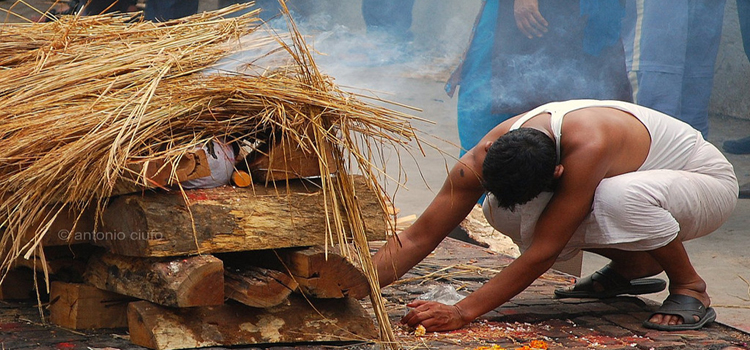The body was washed ashore at a different place. There a holy person by name Babaji, on coming to know of the body, ordered his disciples to bring it to him. Babaji instructed for tonsure and applied the essence of some herbs on the shaven head. Suddenly the body started to breathe. People, on hearing this miracle, started coming in numbers. The Babaji and his disciples thought it fit to leave that village taking the body with them.
After three days Ramendran started to walk slowly. He seemed to have become alright; but he had completely lost his memory the re -born Ramendran became the Babaji’s pet child. He had just the maturity of a kid. He was taught from the alphabet and very soon he learnt and became an expert in hatayoga and ayurveda. He roamed around the Vindhyas, Himalayas and the entire north India with his master Babaji for four years. Finally it was in the Amarnath caves that Ramendran was initiated by the Babaji into the Religious Order.
After some years, while Babaji and Ramendran were camping at Nepal, Ramendran suddenly felt that he did not belong there but was a Bengali. He told Babaji about his strange feeling. Babaji then told him, your time has come. You go… Once this veil of illusion wears, you can rejoin me”.
With holy ash smeared all over his body and wearing a sack in his waist and overgrown, unkempt, coarse and knotted flowing hair and a long beard , Ramendran looked every inch a sanyasi – a recluse. In 1920, the people of Dhaka at Buckland Bund saw the ash-daubed sanyasi on the Buriganga river bank. He sat crosslegged under a tree for four days staring fixedly at the fire burning in front of him. He had tattooed “Baba Damadas’s disciple “ on his hand. He sat on the street for four months and attracted attention because he was of unusually good physical stature. There were rumours that the second kumar had returned .soon people atarted collecting I large numbers to see him.
The Gazipur king was Ramendran’s old friend. He took Ramendran to his palace and provided him all facilities and comforts. The king arranged for Ramendran to go to Joydebpur on 12 April 1921 on the back of an elephant. Ramendran sat in front of the temple. Neither did he realize who he himself was nor those around him. But there was considerable rural acceptance and people were convinced that he indeed was the second son of Bhawal.
Over the following days, his sister became convinced that this sanyasi was indeed the second kumar.
She invited him to the palace. When Ramendran saw his relatives and friends there after a gap of 12 years, he seemed to regain his memory. He wept inconsolably when he learned that his brothers had died already. But his wife Bibhabati refused to meet the claimant and regarded him as an impostor.
Ramendran started recollecting his past. He believed that his wife and his brother-in-law had colluded to kill him. He wanted to regain his rightful heir ship but at the same time he was afraid too that it would entangle him in worldly affairs. He could not decide one way or the other.
In the end, under his sister’s persuasion and persistence, Ramendran agreed to be the heir prince of Bhawal. On 15 May a large crowd gathered before the Jaidebpur Rajbari in Dhaka and announced in public that they believed that he was the returned Kumar. Though his wife never refused to accept him, the public and many tenants of the Bhawal estate continued to support the claimant. Many tenants paid their rents to the claimant,
On behalf of Ramendran’s wife and brother-in-law, a representation was made to the British Government. Following this, the Board of Revenue announced in public on 3 June 1921 that they had proof that the kumar’s body had been cremated in Darjeeling and therefore the claimant was an impostor and that those who paid tenancy rents or tributes to him would only be doing so at their own risk”.
Riots broke out after the public announcement. Many suffered injuries when police fired at mobs who protested violating government controls. One person died in the police firing; Ramendran was prohibited from entering Joydebpur.
On 24 April 1930, lawyers working for the claimant, supported by the sisters and elder sister-in-law of the kumar, filed a declaratory suit in Dhaka claiming the name and property of Ramendra Narayan Ray against Bibhabati Debi. The case went on for six years; 1609 evidences were investigated; 2000 records were submitted. The famous Scotland Yard sleuths were invited. Insurance company physicians examined and confirmed Ramendran’s body identifications.
Babaji was summoned to testify. His disciples too gave supporting testimonies. The palace people and hundreds from the general public were summoned to testify. Even Ramendran’s supposed mistresses were called to the court hearing for cross examinations.
The final judgment on the case was delivered on 24 Aug 1936 in favor of the claimant. The judgment said that the sage was indeed the prince, that the brother-in-law of the prince administered poison to the prince, that the body of the prince was cremated but a hailstorm doused the fire.
Ramendran’s wife filed an appeal in the Calcutta High Court against the verdict. After four years of trial, the Calcutta High Court upheld the verdict of the lower court.
But Bibhabati Debi was not ready to give up. Developments of the war delayed further appeals until 1943, when lawyers for Bibhabati Debi filed for a leave to appeal against the judgment of the High Court in the Privy Council in London. The hearing lasted for 28 days. On 30 July 1946 they ruled in favor of the claimant and dismissed the appeal. This was the front page news in the dailies coming from Dhaka and Calcutta. Thousands sent their congratulatory messages by telegram to Devendran. Bhawal estate wore a festive look for many days.
India was on the verge of gaining independence .Since people believed that the brother-in-law acted with the British government, popular support for Ramendran swelled.
But Ramendran did not participate in those festivities. He remained silent and alone. He spent most of his time in deep meditation. At the same time, Babaji’s disciples observed that Babaji too had entered into a Samadhi state.
When the claimant went to offer prayers, he suffered a stroke and died two days later. Funeral rites were performed on 13 August 1946. People had come to the cremation with umbrellas hoping it would rain. But it didn’t this time.
The Prince just merged with Babaji and became one with him.
——————————————-THE END————————————-
Written by Dravida Maayai Subbu along with Sri Rajagopalan Venkatachary




